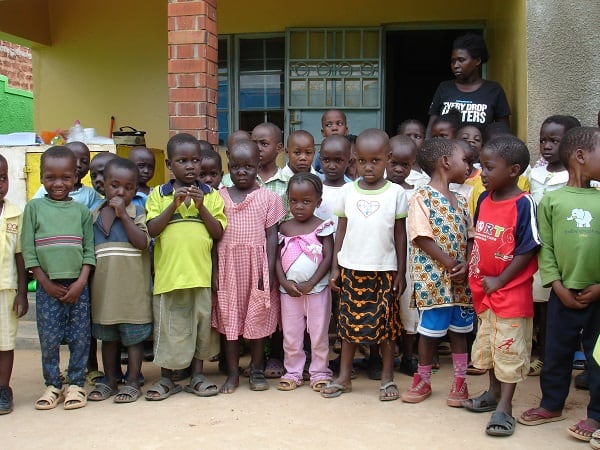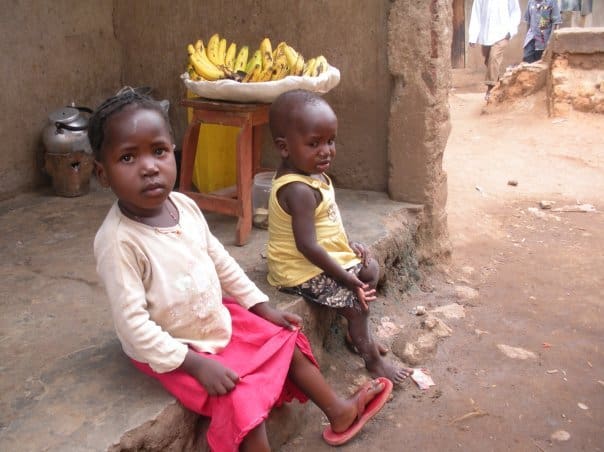Home » Little Light Kindergarten
Little Light Kindergarten
The Little Light Kindergarten provides free pre-school education to over 60 children aged 3-6 living in extreme poverty in the Namuwongo Slum. Originally founded in 2008 by Israeli volunteers working in Namuwongo, Uganda, the kindergarten now operates as a self-sustaining, independent organization.Professionally supervised facilities, such as the Little Light Kindergarten, provide safe environments that help to improve children’s physical and mental wellbeing.
In 2007, Dr. Sophie, a British-Israeli doctor, came to volunteer in Uganda through Brit Olam’s Helping Hands Medical Fellowship project, which offered free medical services to the population of the Namuwongo Slum. Sophie came to realize that many of the children were not sent to school, and were therefore roaming around in the slum aimlessly without any prospects for the future. With the help of local volunteers and Israeli Brit Olam volunteers Avia, Naama, and Anat, Sophie decided to gather as many of these children as possible and to provide them with some kind of informal education. At first, volunteers were given permission to use three abandoned structures where they carried out their activities of playing, singing, dancing, providing some health education, and teaching basic reading and writing. When Sophie and her Israeli partners left, the local volunteers continued with these activities.
Then came the next group of Israeli volunteers, including Dr. Shiri (Helping Hands) and Hadar and Yasmin, two young Brit Olam volunteers who came to volunteer in Uganda before their army service in Israel. The girls complemented the local volunteers’ morning work with afternoon activities for the children. These activities were carried out in a roofless, unfinished structure, where the children were exposed to the sun and rain. Yasmin and Hadar started to fundraise in order to build a structure that would protect the children from extreme weather.
A piece of land was donated by a community leader on the outskirts of the slum, and a bamboo structure was erected with the help of the funds which the girls had raised and with the help of the Israeli community in Kampala, who donated many of the materials and gave a hand in building the structure.
The Little Light Kindergarten, the compound included a bamboo structure divided into three classrooms, a pit-latrine, and a small courtyard and can serve up to sixty children. It was decided that the center would focus on the younger children (3–6 years old) and on pre-school education.When the Center was finished, Shiri, Hadar and Yasmin had to go back home and they left the project in the caring hands of Qasasa, the head teacher of the school, and Netta, an Israeli studying in Uganda.
The 1st term of the Little Light Kindergarten started in January 2008 with 67 children (we couldn’t say no…). During this term, after managing to raise the funds needed, Brit Olam also started giving the children a healthy breakfast every day. The main challenge the Center was facing was the rainwater that kept coming in from the grounds around the classrooms. During the term break, the Center received a very generous donation from the Israeli building company “Solel Boneh” (SBI) that built not only a drainage system to keep the rain out, but also a cement floor for all the classrooms.The Little Light Kindergarten continues to serve children in need in the Namuwongo Slum, and is now able to operate independently.
Namuwongo is the second largest slum area in Kampala, Uganda. It is home to tens of thousands of people, most of whom are refugees from Northern Uganda and Congo. Due to high fertility rates, the majority of the people living in the slum are children.
The slums provide residents with the lowest standards of living in the country. Unemployment rates are very high, and most people live in extreme poverty. The majority of dwellings are made of leftover scrap materials or mud, and the population is extremely dense. Families often crowd into small, single room dwellings that do not have running water. In addition, most do not have pit latrines. Rather, people use the few common pit latrines or take care of their bodily functions outside; sewage flows in small streams down many streets.
The congested and unhygienic conditions in Namuwongo are the primary causes of infectious diseases, and many people often suffer from various illnesses.
Children of the Slum
Children living in the harsh conditions of slums such as Namuwongo face many dangers, both inside and outside their homes. They are often exposed to drunkenness, neglect, abuse, malnutrition, and diseases. Many parents cannot afford to send their children to school, and even fewer to nursery school. As a result, children spend virtually all of their time out in the streets selling food items, collecting scraps, or just roaming around.
Most children live with a single parent (usually the mother) after the other parent has deserted them or passed away. Some have lost both parents to illnesses such as AIDS, or have been orphaned by violent acts and accidents. As a result, they are often taken care of by distant relatives. Unfortunately, however, these caretakers lack the will or, more frequently, the means to care for the children.
Copyright © 2022 Brit Olam



